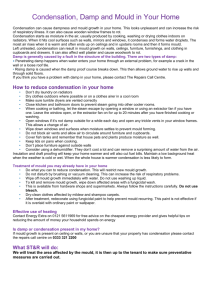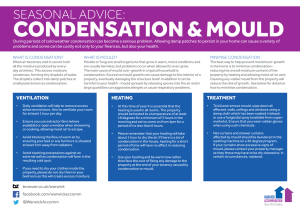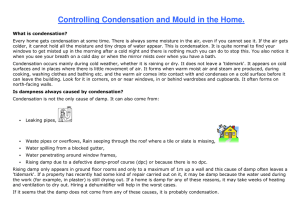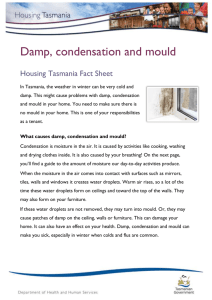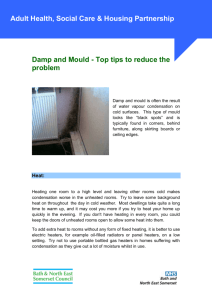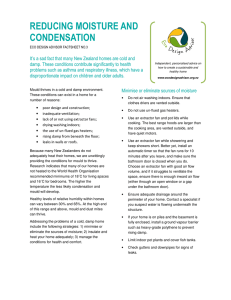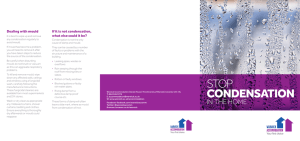Preventing damp and mould caused by condensation
advertisement
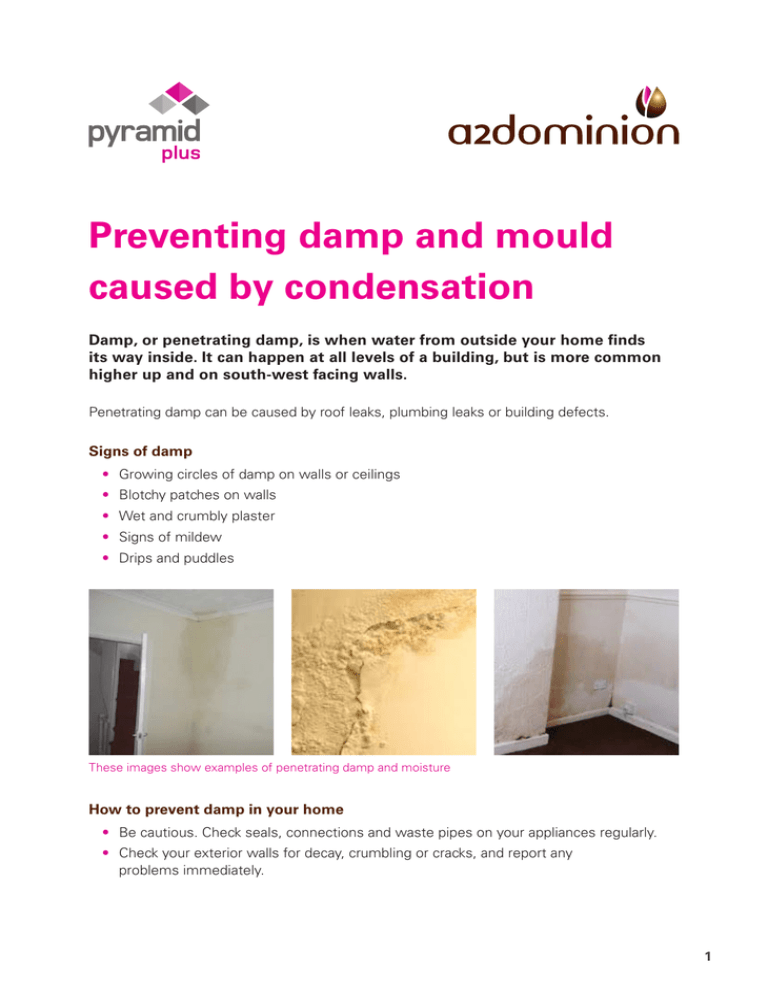
Preventing damp and mould caused by condensation Damp, or penetrating damp, is when water from outside your home finds its way inside. It can happen at all levels of a building, but is more common higher up and on south-west facing walls. Penetrating damp can be caused by roof leaks, plumbing leaks or building defects. Signs of damp • Growing circles of damp on walls or ceilings • Blotchy patches on walls • Wet and crumbly plaster • Signs of mildew • Drips and puddles These images show examples of penetrating damp and moisture How to prevent damp in your home • Be cautious. Check seals, connections and waste pipes on your appliances regularly. • Check your exterior walls for decay, crumbling or cracks, and report any problems immediately. 1 Possible locations of damp • Rising up internal walls at low level • Ceilings • Random areas on external walls How do we treat damp? If you are a tenant and you find signs of damp in your home, you should report this to us as a repair. We may send out a surveyor to investigate the problem, and find out how the water is getting into your home. One of our contractors will then visit your home to repair the damp and redecorate the affected area. If you are a homeowner, you are responsible for treating any damp in your home. What is condensation? When you take a cold bottle out of the fridge, you will see water droplets form on the outside of the bottle. This is condensation. It happens when the warmer air in the room touches the cold surface of the bottle and cools down. Cool air can’t hold as much moisture as warm air, so this moisture ‘condenses’ and collects on the outside of the bottle. When the warm, moist air from things like cooking, bathing and even breathing touches a cold surface in your home, water droplets will form in the same way. If you leave this water on those surfaces, you will start to get black spots of mould. If you find black spots of mould around your walls, bath, sinks or windows, they may be caused by condensation rather than damp. These images show examples of condensation, and mould caused by condensation Where do we get condensation? We see condensation in places where you get steam, such as around the kitchen sink and window, and around the bath or shower area. We even see it in the corners of bedrooms, as these areas are colder than the rest of the room. You can also find condensation on walls behind furniture, behind peeling wallpaper and on clothes. 2 Why is it a problem? Condensation is usually a problem during the winter, because we tend to close windows and doors. We do this to keep heat inside the house, but moist air will still find its way to the cooler surfaces, condense and, over time, form mould. How to avoid condensation Prevention is better than cure. Taking these simple steps could prevent condensation that may turn into mould: 1.Background heating - if you are at home, leave the heating on a low temperature setting, ideally 19 to 21 degrees Celsius. This means you are keeping your home at a constant warm temperature so the chance of moisture finding a cold surface will be reduced. By doing this, your boiler will work more efficiently and therefore won’t cost as much as it would if you heated your home from a cold temperature each time you turned on your boiler. 2.Ventilation - close doors and open windows slightly wider when you are cooking, washing or bathing, as this will remove moisture from the room and help prevent moisture from travelling throughout the property. All bathrooms and kitchens are fitted with an extractor fan. Make sure the vents are clean and clear of clutter, and that the fans are switched on when you are using these rooms. 3.Cooking - cover pans when cooking if possible to minimise steam and moisture moving around the property. 4.Drying wet clothes - if you are drying wet clothes and laundry indoors, put them in a room with an extractor fan, open the window and keep the door closed. 5.Storage - avoid overfilling cupboards and wardrobes, and leave a space between outside walls and furniture. 6.Mornings - in bedrooms in the morning, you may see that condensation has formed on the inside of windows. Where possible, leave the bedroom window slightly open as this should help prevent condensation from forming. If you are unable to leave the bedroom window open, then simply wipe off the condensation with a dry cloth and wring the cloth out in the sink to help prevent mould forming. Everyday actions that create moisture in your home Daily sources of moisture One person asleep for eight hours One person active for 16 hours Cooking Bathing Washing clothes Drying clothes Paraffin heater Moisture created 0.3 litres 0.8 litres 3.0 litres 1.0 litres 0.5 litres 5.0 litres 1.7 litres Approximately equal to One can of soft drink Four cups of tea Two large bottles of water One 2 pint carton of milk One regular bottle of water Two 4 pint cartons of milk A 2 pint and 1 pint carton of milk How to spot when condensation is affecting your home • Look – you may see water forming on the inside of your windows, black spots of mould on walls or window frames, and peeling paintwork and wallpaper. • Smell – condensation can cause a damp, humid smell as if you have left damp clothes or towels rolled up somewhere in your home. • Feel – if your home feels very cold even though the heating is on full, you could have condensation in your home. How to control mould that has already formed from condensation 1.Wipe away black spots of mould with a domestic anti-fungal wash. You can get these from DIY shops and supermarkets. Do not brush or vacuum the surface as this may spread the mould. 2.After treating the area, we recommend you redecorate it using a fungicidal paint to stop the mould coming back. 3.If you see moisture on your walls and windows, wipe them with a dry cloth and wring out the cloth rather than drying it on a radiator to prevent sending the moisture back into the air. 4.Open the windows if you have a lot of people, pets or plants in the room. Mould growth requires regular treatment and monitoring. If after eight weeks you feel there is still an issue with mould in your home, please report it to our Customer Services Centre. Remember: to prevent and control mould you must try to keep your home well-ventilated. You are responsible for keeping your home in good order. For more advice or to discuss a particular issue, please contact us. Contact us Online: www.a2dominion.co.uk/customers By email: customer.services@a2dominion.co.uk By phone: 0800 432 0077 (Monday to Friday, 8:30am to 5:30pm) In person or by post: by visiting or writing to one of our main or local offices. My Account My Account lets you check your account online, anytime. You can view your statement, see your recent transactions, report or track a repair, and more. Register today at www.a2dominion.co.uk/myaccount. Translations We’ll consider requests for translations into other languages and formats including large print, audio and Braille. 000556/11/15 - CU 4
